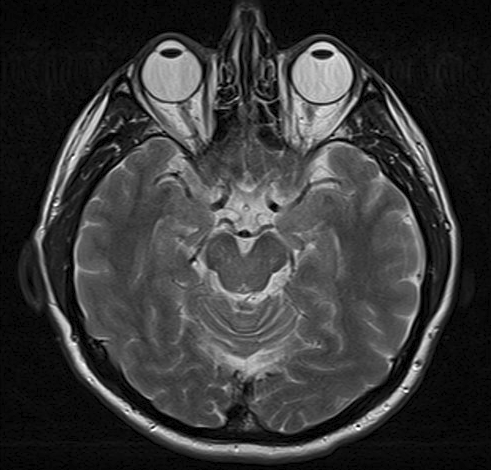MRI scan
Peer reviewed by Dr Colin Tidy, MRCGPLast updated by Dr Toni Hazell, MRCGPLast updated 7 Aug 2023
Meets Patient’s editorial guidelines
- DownloadDownload
- Share
- Language
- Discussion
An MRI scan is a safe and painless test that can provide detailed pictures of organs and other structures inside your body.
Note: the information below is a general guide only. The arrangements (and the way tests are performed) may vary between different hospitals. Always follow the instructions given by your doctor or local hospital. These are usually included with your appointment letter.
In this article:
Continue reading below
What is an MRI scan?
MRI stands for magnetic resonance imaging. An MRI scan uses a strong magnetic field and radio waves to create a detailed image on a computer screen. It can show different types of tissue, organs and other structures inside your body.
This image is an MRI scan of a brain. The person's eyeballs can be seen at the top of the picture.
MRI scan

By Ptrump (Own work) via Wikimedia Commons
How does an MRI scan work?
Your body contains millions of hydrogen atoms. When you are in an MRI scanner:
A strong magnetic field aligns particles called protons which are within the hydrogen atoms. All the protons line up in parallel to the magnetic field, like tiny magnets. (Normally the millions of protons all lie in random directions.)
Then short bursts of radio waves are sent from the scanner into your body. The radio waves knock the protons from their position.
When the burst of radio waves stop, the protons realign back into place. As they do so they emit radio signals. The protons in different tissues of the body realign at different speeds. Therefore, the signal emitted from different body tissues varies. So, for example, softer tissues can be distinguished from harder tissues on the basis of the signals sent.
These signals are detected by a receiving device in the scanner.
The receiving device transmits the signals to a computer. The computer creates a picture based on the radio signals emitted from the body.
Continue reading below
What does an MRI scan involve?
The MRI scanner is like a tunnel about 1.5 metres long, surrounded by a large circular magnet. You lie on a couch which then slides into the scanner. A 'receiving device', like an aerial, is placed behind, or around, the part of the body being examined. This detects the tiny radio signals emitted from your body. When each 'picture' is being taken you need to keep still for a few minutes, otherwise the scan picture may be blurred.
MRI scanner

By Jan Ainali (own work) via Wikimedia Commons.
The scan itself is painless. The whole procedure can take 15-40 minutes. It may be a little uncomfortable lying still on the couch for this time. Small children may need a general anaesthetic to keep them still long enough for the pictures to be taken. Where you lie is quite enclosed and some people may find this very unsettling.
If you have a fear of confined spaces (claustrophobia) you should discuss this with your doctor before you go for the scan. Some parts of the country have access to 'open' scan machines. However, they are not widely available and there is usually a longer wait for an 'open' scanner than for a closed scanner.
In some cases, an injection of a special contrast dye is given into the bloodstream via a vein on the arm. This helps to give clearer pictures of certain tissues or organs being examined.
The radiographer sits in the control room next to the scanner and observes through the window. However, you can talk to them, usually via an intercom, and you will be observed at all times on a monitor.
The scanner is noisy so you will be given some headphones or earplugs to protect your ears from the noise. Quite often you can listen to the radio or music through the headphones.
What is an MRI scan used for?
An MRI scan can create clear pictures of most parts of the body. So, it is useful for all sorts of reasons where other tests (such as X-rays) do not give enough information required.
It is commonly used to obtain detailed pictures of the brain and spinal cord, to detect abnormalities and tumours. Even torn ligaments around joints can be detected by an MRI scan. So it is being used more and more following sports injuries.
Brain
MRI is the first-choice investigation for brain tumours, as it produces clearer images than computerised tomography (CT) and shows hard-to-reach areas of the brain. There is clear contrast between grey and white matter parts of the brain and this makes MRI the best choice for many other conditions, including multiple sclerosis, stroke, Alzheimer's disease and epilepsy.
Musculoskeletal system
Here, MRI is used to look at the spine - to assess joint disease, pressure on nerves and soft tissue tumours.
Gastrointestinal system
MRI allows non-invasive assessment of inflammatory bowel disease and bowel tumours. It can also look at problems in the liver and pancreas.
Blood vessels and the heart
This is called magnetic resonance angiography (MRA) and it generates pictures of the arteries to look for abnormal narrowing or vessel wall dilatations (those at risk of bursting). MRA is often used to evaluate the arteries of the neck and brain, the thoracic and abdominal aorta, the renal arteries, and the legs. It might also be used to assess congenital heart disease.
Continue reading below
Preparing for an MRI scan
Your local hospital should give you information about what is required before you come for the scan.
The MRI scanner uses an extremely strong magnet, so people with certain types of medical implant cannot be scanned. This is because the magnet can potentially move medical devices with metal in them, or affect their function.
Therefore, before you enter the scanning area you should be asked if you have any medical devices in your body. You may have to fill in a safety questionnaire that asks about things that may contain metal. The following is not a definitive list but may help to remind you of the type of things radiographers need to know about:
Internal (implanted) defibrillator or pacemaker.
Ear (cochlear) implant.
Surgical clips such as those used on brain aneurysms.
Artificial heart valves.
Implanted medicine infusion ports.
Artificial limbs or metallic joints.
Implanted nerve stimulators.
Pins, screws, plates, stents or surgical staples.
It is also important to tell the radiographer if you have ever had any metal fragments lodged in your eyes or your body. In some cases you may need an X-ray before an MRI scan, to make sure you are safe to enter the scanner.
Side-effects of an MRI scan
MRI scans are painless and thought to be safe. MRI scans do not use X-rays so the possible concerns associated with X-ray pictures and CT scans (which use X-rays) are not associated with MRI scans.
However:
Rarely, some people have reactions to the contrast agent which is sometimes used.
Pregnant women are usually advised not to have an MRI scan unless it is urgent. Although the scan is thought to be safe, the long-term effects of strong magnetic fields on a developing baby are not yet known.
What to expect after the MRI scan
There are no after effects from the scan. You can return to your normal activities as soon as the scan is over. The scan pictures are studied by a specialist who interprets them - a radiologist - who sends a report to the doctor who requested the scan.
It is usual to have to wait for at least two weeks before hearing about your results. If there are any urgent findings, the specialist will be informed as soon as possible. The result will go back to the person who requested the scan. So, if a hospital consultant requests a scan, you will get the result at your next appointment with them. If you are concerned, you could ring their secretary, but do not contact the GP for the result as they will not have it. If the GP has requested an MRI, you will get the result from them.
Patient picks for Imaging

Tests and investigations
Ultrasound scan
An ultrasound scan is a painless test that uses sound waves to create images of organs and structures inside your body. It is a very commonly used test. As it uses sound waves it is thought to be very safe. Doppler and duplex scans are used to visualise blood or fluids flowing through the body. Note: the information below is a general guide only. The arrangements, and the way tests are performed, may vary between different hospitals. Always follow the instructions given by your doctor or local hospital.
by Dr Toni Hazell, MRCGP

Tests and investigations
X-ray test
X-ray tests show bones and certain other tissues.
by Dr Hayley Willacy, FRCGP
Further reading and references
- MRI Scan; Cancer Research UK; 2022
Continue reading below
Article history
The information on this page is written and peer reviewed by qualified clinicians.
Next review due: 5 Aug 2028
7 Aug 2023 | Latest version

Ask, share, connect.
Browse discussions, ask questions, and share experiences across hundreds of health topics.

Feeling unwell?
Assess your symptoms online for free
Sign up to the Patient newsletter
Your weekly dose of clear, trustworthy health advice - written to help you feel informed, confident and in control.
By subscribing you accept our Privacy Policy. You can unsubscribe at any time. We never sell your data.